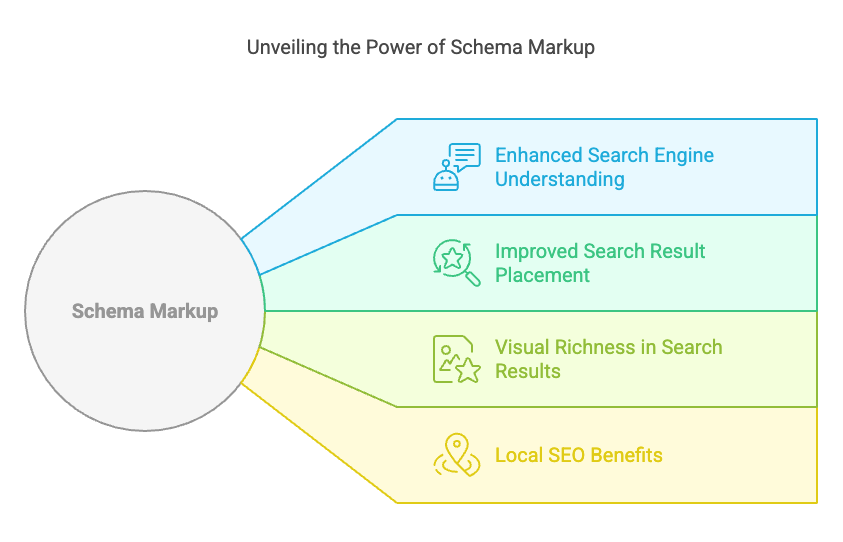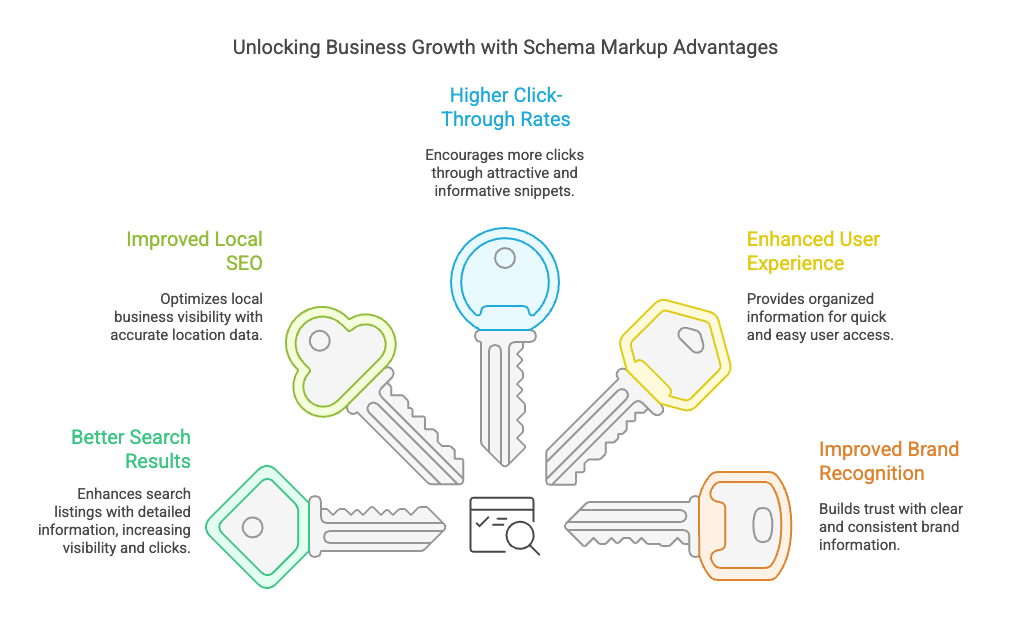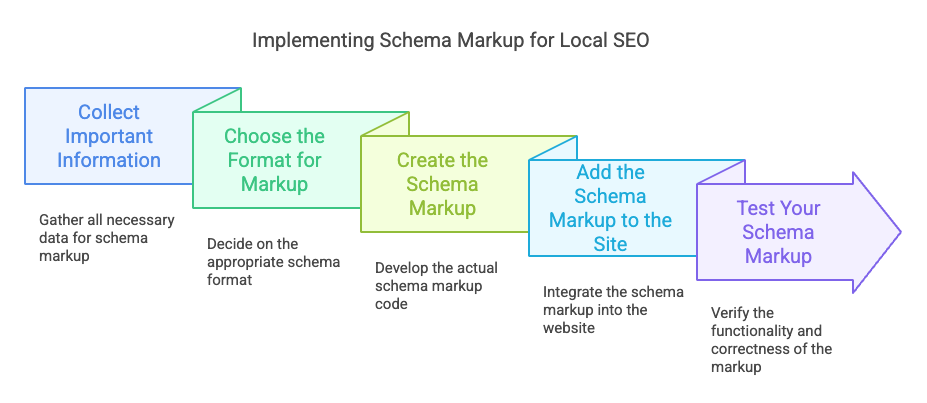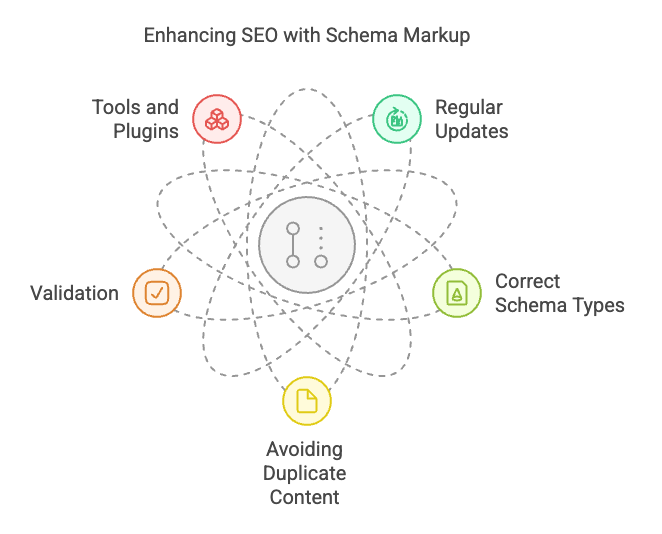In digital marketing, schema markup is a useful tool that helps a business appear better in search results. By using schema markup, businesses can give search engines clear information about where they are located and important details about them.
This organized information helps crawlers understand and show details about the business better. This can lead to good rankings in local searches and a better presence on Google Maps. This makes it easy for potential customers to find important information.
By using schema markup for local SEO, businesses improve their visibility online and make sure their information is shown clearly and correctly in search results. This post will explain how to use schema markup step by step and share the best ways to do it.
What is Schema Markup?
It is a kind of special code that can be added to any site to help crawlers understand your pages better. This can improve your site placement in search results. It’s a list of special tags that helps bots understand the information on your web pages better.

By adding this organized information to your website, you give bots clear details about your business. These small pieces of data can have pictures, star ratings, event details, and other important facts about your business.
The main aim of schema markup is to help crawlers understand your content better. This involves putting a special code into your HTML. You can do this yourself or use tools called schema markup generators to help you.
Schema markup is a vital part of Google Maps SEO marketing services as it helps search engines better understand and display local business information, improving visibility and relevance in local searches.
Advantages of Using Schema Markup

Better Search Results
Schema markup improves search results by making them more detailed. This includes extra information like pictures, star ratings, event details, and more. Rich snippets help your listings shine in search results, getting more attention and clicks.
For example, a product page with special coding can show the product’s price, if it’s in stock, and customer ratings right in the search results. This increased visibility can result in more people clicking on your site and bringing more visitors to it.
Rich snippets give users helpful information quickly, making their search easier and more enjoyable. Better search results not only bring in more visitors but also make it more likely that they will buy from you, which helps your business grow.
Improved Local SEO
Using schema markup really helps improve local SEO by making it easier for bots to know where your business is located. Local business schema helps you share important information about your business like its name, address, phone number, and opening hours.
This helps search engines show your business correctly in local searches and on Google Maps. For example, a nearby restaurant can use schema markup so that its address and opening hours show up in search results. This helps customers find it more easily. Embedded maps benefits local rankings of a website.
Having correct and reliable information about your local business helps search engines trust your data. This can boost your ranking and make it easier for local customers to find your business.
Higher Click-Through Rates
Schema markup can make your search results look nicer and provide more information, which can help more people click on them. Rich snippets made with schema markup show extra data like ratings, prices, and event details, which helps your listings get noticed.
For example, an online shopping website that uses product schema markup might show product pictures, prices, and ratings right in the search results. This extra information can encourage people to visit your website to find out more.
Higher click-through rates bring more visitors to your website and also show crawlers that your content is geo targeted, important, and useful. Using schema markup helps organize your data, which improves the user experience. This makes it simpler for potential customers to discover and interact with your content.
Enhanced User Experience
Schema markup improves the experience for users by giving clear and organized information right in the search results. This helps users find the information they need fast and easily.
For example, a doctor or healthcare provider can use a review system to show patient ratings and comments. This helps people looking for a provider make better choices. Being open and clear helps people trust us and makes their experience better.
Also, schema markup helps make sure that users get correct and updated information, which lowers the chance of frustration and improves their experience on your website. Good schema markup can make your content easier to access, helping people with disabilities use it better. Improving page load speed also enhances user experience.
Improved Brand Recognition
Schema markup helps your brand stand out and be trusted by making sure your business information is shown correctly and clearly in search results. Using organization schema, you can give clear information about your business.
Being consistent and easy to see helps create a strong online brand. When people see your official logo and contact information in search results, it makes your brand appear more trustworthy and reliable.
When businesses share clear and trustworthy information, users are more likely to interact with them. By having a clear and professional appearance for your business, you can be different from other businesses and attract more potential customers.
Implementing Schema Markup for Local SEO

Step 1: Collect Important Information
The first step to setting up a local business schema is to collect all the important data about your business. This information will help fill out the schema markup and make sure search engines have the correct details about your business. Here’s a clear list of what you’ll need:
Business Name: The name of your business that will show up when people search for it.
- Physical Address: The full address of your business, which includes the street, city, state, and zip code. This helps search engines find your exact location.
- Phone Number: A number that customers can call to connect with you. Make sure this number is the same on all your online listings.
- Operating Hours: The days and times when your business is open. Giving correct hours lets customers see when they can come or get in touch with you.
- Geo-coordinates: The latitude and longitude of where your business is located. These numbers help search engines find your business correctly.
- Business Category: The kind of business you run (like a coffee shop, or plumbing service). This helps search engines know what services or products you provide.
- URL: The web address of your business’s official website. This helps search engines connect the schema markup to your website.
- Logo Image: A web link to your business logo. Adding your logo helps people remember your brand.
Having this information easy to access helps make the implementation process easier and makes sure your schema markup is correct and complete.
Step 2: Choose the Format for Markup
Next, you need to choose the type of format for your schema markup. There are two main formats: Microdata and JSON-LD which is JavaScript Object Notation for Linked Data. JSON-LD is often chosen for a few main reasons:
- Easy to Use: It’s simpler to add JSON-LD to your website’s HTML code. You can put it in the <head> part of your document without changing the HTML elements directly.
- Maintenance: JSON-LD is easier to manage because it is kept separate from the HTML content. This separation makes it easier to handle updates and changes.
- Google’s Suggestion: Google suggests using JSON-LD for organized data. This support means that Google is more likely to understand and use JSON-LD in its search results.
By using JSON-LD, you make it easier to add and manage your schema markup, making sure you’re following best practices.
Step 3: Create the Schema Markup
Now that you have all the needed information and have picked your format, it’s time to make the schema markup. You can use a tool to create schema markup or write the code yourself. Here’s a local business schema in JSON-LD format:
json
<script type="application/ld+json">
{
"@context": "https://schema.org",
"@type": "LocalBusiness",
"name": "Business",
"address": {
"@type": "PostalAddress",
"streetAddress": "123 Main St",
"addressLocality": "BayArea",
"addressRegion": "CA",
"postalCode": "12345",
"addressCountry": "US"
},
"geo": {
"@type": "GeoCoordinates",
"latitude": "37.7749",
"longitude": "-122.4194"
},
"url": "https://www.site.com",
"telephone": "+1-555-555-5555",
"openingHours": "Mo-Fr 09:00-17:00",
"priceRange": "$$",
"image": "https://www.site.com/logo.png",
"description": "Business is a leading provider of services in BayArea, CA."
}
</script>This JSON-LD script contains important information about your business. It helps bots easily understand the location and what services you offer. Each important part is clearly explained in the schema, so they can easily understand and show the information.
Step 4: Add the Schema Markup to the Site
The next step is to add the JSON-LD code onto your website. Here’s how you can do it:
- Open Your HTML File: Use a text editor or your website’s content management system to open the HTML file for your webpage.
- Find the <head> Section: Look for the <head> part of your HTML document. The <head> section is a good spot for schema markup because it helps search engines find and understand it easily.
- Add the JSON-LD Code: Place the JSON-LD code inside the <head> part of the webpage. Here’s an example:
html
<!DOCTYPE html>
<html>
<head>
<title>Business</title>
<script type="application/ld+json">
{
"@context": "https://schema.org",
"@type": "LocalBusiness",
"name": "Business",
"address": {
"@type": "PostalAddress",
"streetAddress": "123 Main St",
"addressLocality": "BayArea",
"addressRegion": "CA",
"postalCode": "12345",
"addressCountry": "US"
},
"geo": {
"@type": "GeoCoordinates",
"latitude": "37.7749",
"longitude": "-122.4194"
},
"url": "https://www.example.com",
"telephone": "+1-555-555-5555",
"openingHours": "Mo-Fr 09:00-17:00",
"priceRange": "$$",
"image": "https://www.example.com/logo.png",
"description": "Business is a leading provider of services in BayArea, CA."
}
</script>
</head>
<body>
<!-- Your website content goes here -->
</body>
</html>- Save and Upload: After saving the changes to the HTML file, upload it to the website if you are working offline. If you’re using a CMS, go ahead and publish the updated page so everyone can see the changes.
Adding the JSON-LD code in the <head> part of your page helps search engines find and understand the schema markup easily when they first crawl your page.
Step 5: Test Your Schema Markup
After the schema markup implementation in your site, it’s important to check it to make sure it works properly. Google’s Rich Results Test tool is a useful tool for this. Here’s how to use it:
- Open the Tool: Visit Google’s Rich Results Test.
- Type Your URL: In the box provided, put the URL of the page where you added the schema markup and click “Test URL”.
- Check the Results: The tool will look at your page and show you the results. Check for any mistakes or alerts that need fixing. The tool shows any problems it finds and gives ideas on how to fix them.
- Fix Problems: If you see any mistakes or alerts, return to your HTML file and change it as needed. Common problems can be missing needed information, wrong format, or items placed in the wrong location in the JSON-LD script.
- Test Again: After fixing the problems, use the Rich Results Test tool to test the page again. This will help you confirm that all the issues are fixed and that your schema markup is now correct.
Testing your schema markup regularly makes sure it’s correct and works well, which helps improve local SEO and search rankings.
Best Practices for Schema Markup Implementation

Update Schema Markup Regularly
It’s important to keep your schema markup up to date so that your business information shows up correctly in search results. As your business grows, things like your address, phone number, business hours, and services might change.
Making sure your schema markup has these updates helps avoid wrong information and lets search engines show the latest data to people looking for it. Regularly checking and updating your schema markup can help find any mistakes that you might have missed.
Keeping your schema markup current improves your business’s trustworthiness, so customers can find correct information easily. Make a plan to check and update your schema markup regularly, like every three months or after big changes.
Use the Right Types of Schemas
Choosing and using the right schema types for your business is very important to make the most of your structured data. Different types of schemas give useful information that can improve different parts of your search results.
For example, a local business schema shows where you are and how to contact you, while a product schema displays the features and availability of your products. Using an organization schema can show important information about your business.
Picking the right schema types helps search engines understand your business correctly. Also, using several important schemas can give a clearer and more complete picture of your business, which helps more people see it and interact with it.
Changing your schema types to fit your needs can really help your SEO performance. Frequently checking the types of schemas you can use and updating your setup when necessary helps keep your structured data useful and up-to-date.
Avoid Duplicate Content
It’s important to make sure your schema markup correctly shows the unique content on your website to prevent problems with duplicate content. Having duplicate content can confuse bots, which can result in lower rankings and a bad experience for users. Unique content helps with local keyword optimization.
When using schema markup, check your website to make sure that each piece of structured information is different and fits well with the page it’s on. Don’t use the same schema markup on different pages unless it truly matches what those pages are about.
Instead, adjust your schema markup to match the unique information and context of each page. Keeping your schema markup unique helps make your site more trustworthy and respected. This leads to improved performance in search engines and happier users.
Validate Your Markup
Validating your schema markup for local SEO with tools like Google’s Rich Results Test is important to make sure it is set up correctly. This process helps find mistakes or problems in your structured data that could impact your search rankings.
The validation tools give you clear feedback on what to fix, so you can make specific corrections. Regularly checking your schema markup helps keep it correct and useful. It also makes sure that your organized data meets the latest rules and good practices.
Make it a habit to check your schema markup regularly, especially after changing your website. Checking your data properly can stop problems before they affect how well you search, making sure your structured data functions correctly.
Use Tools and Plugins
Using tools and plugins can make it easier to implement and manage schema markup. Many content management systems provide plugins that make it easier to create and add structured data.
For example, tools like Yoast SEO and Schema Pro help users add and change schema markup easily, even if they don’t have much technical knowledge. These tools usually have easy-to-use designs and ready-made templates for different types of schema.
Google’s Structured Data Markup Helper can help you create the right code for your website. Using tools and plugins not only helps you save time but also improves the quality and performance of your structured data, making it easier to be found by search engines.
Wrapping Up
Schema markup implementation in your website is an important way to help Google better understand where your business is located and how it relates to users. By using organized data, you help crawlers understand and show your business information correctly.
This can help your business go up in local search results pages and be more noticeable on Google Maps. This better visibility helps potential customers find your business more easily and builds trust by showing clear and complete information.
By using good methods and taking advantage of schema markup, you can greatly improve your online visibility and draw in more local customers, which will help your business grow and succeed. It is a crucial component for your online business.
FAQs
What is JSON-LD, and why is it suggested for schema markup?
JSON-LD is a way to organize information and include it in your website. It is suggested because it is simpler to use and take care of. JSON-LD lets you add organized data in a separate section, so it stays separate from your HTML content. This separation makes it easier to update and manage organized information. Also, Google likes JSON-LD for structured data because it helps its search algorithms understand information better.
How can I make sure my schema markup is implemented correctly?
Google’s Rich Results Test checks your code and points out any mistakes or issues you need to fix. The validation process gives you clear feedback on any problems, so you can fix them accurately. Testing your schema markup often helps keep it correct and working well. Also, using different tools can help you see how your structured data is doing in search results and show you where you can make it better.
Can schema markup help improve my search engine rankings?
Yes, Schema markup helps search engines understand your content more clearly by organizing your data. This can make your site show up better in search results. Better search results with extra details can help more people click on your link, which can improve your rankings. When search engines show special details about your pages, people are more likely to click on them.
What mistakes should I be careful about when using schema markup?
Mistakes that can be avoided when using schema markup are choosing the wrong types of schema, not updating the markup with new business details, not checking if the markup is correct, repeating content on different pages, and adding the markup in the wrong part of the HTML. For example, don’t use local business tags on product pages, and make sure to check and update your information often to keep it accurate.
How often should the schema markup be updated?
You should update your schema markup whenever your business information updates. Updating the markup often helps search engines get the latest information about your business, making it more accurate and trustworthy. Also, make a regular schedule, like checking things every three months, to keep everything relevant and important. Keeping your information updated helps avoid mistakes and keeps your data accurate.


























